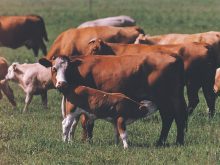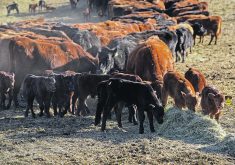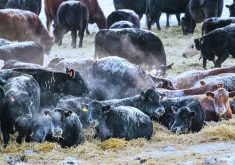Polioencephalomalacia, known as PM, is a disease of the nervous system that can kill cattle within hours. It usually strikes animals less than two years of age either when they are moved from marginal pasture to lush grass or when they enter the feedlot and are placed on high concentrate diets.
Because PM attacks with deadly speed, early recognition and prompt treatment are essential. The first symptom calves exhibit is “stargazing” – they peer into the sky as if looking at imaginary stars. Next, they become blind, bumping into things as they walk.
Read Also

Childhood memories of ‘magical’ combines last a lifetime
Combines are bigger, faster, more comfortable and more expensive. But I suspect one thing hasn’t changed for the kids riding in them: the thrill of climbing the stairs and entering that world.
As brain damage progresses, they become disoriented and wander aimlessly. They stagger as if they are drunk, desperately trying to maintain their balance and eventually losing their ability to stand.
Within hours, sometimes less, their legs become stiff and their backs and necks arch. This symptom is called opisthotonus.
Finally, animals with PM will have seizures. The prognosis for recovery at this stage is poor because death follows so quickly.
Polioencephalomalacia means softening of the brain’s grey matter.
The cause, in this case, is lack of thiamine, also known as vitamin B1. This nutrient plays a vital role in the activation of transketolase, an enzyme needed to move molecules and water in and out of brain cells.
When thiamine is lacking, transketolase is unable to function so brain cells swell and die. The extent of the death of brain tissue determines the severity of the nervous signs.
A specific diagnosis can only be made when looking at cross-sections of the brain on a post-mortem.
In living animals, PM is difficult to diagnose with certainty.
Though PM is caused by thiamine deficiency, a thiamine-deficient diet is rarely at the root of the problem. More typically, dietary thiamine is made unavailable before it can be used.
PM has been reported in cattle that are fed diets or offered water high in sulfur. This mineral is believed to bind to thiamine, preventing it from being absorbed.
In most cases, PM is caused by an abrupt change in feed. A sudden diet switch stimulates a shift in rumen microflora. In particular, it causes a proliferation of bacteria that produce thiaminase, an enzyme that breaks down thiamine in the feed. Though cattle consume enough thiamine, too little is ultimately absorbed.
Because PM can be treated with injections of thiamine, many veterinarians refer to this disease as “thiamine responsive.” In fact, the response to a thiamine injection can be dramatic. Most cattle improve within 24 hours of a single dose. Treatment should always continue for three days, even if animals recover sooner.
Cattle that do not respond to thiamine therapy probably have some other type of nervous disease.
If PM is suspected, thiamine should be administered as quickly as possible to prevent permanent brain injury. When treatment is delayed for more than eight hours after the signs are first detected, full recovery is unlikely because scarring of brain tissue causes neurological deficits.
The dose of thiamine varies from 10 milligrams per 45 kilograms body weight three times daily to 100 mg per 45 kg once daily, depending on the product used.
Because the trigger for PM is well recognized, prevention is possible, with slow feed changes being key.
To give their rumens time to adjust, cattle should be allowed access to new pastures for just a few hours each day. Also, cattle moved into feedlots should be switched to high concentrate diets over a minimum of two weeks.
Thiamine supplementation at the rate of three to 10 mg per kg of feed can be beneficial under conditions of high concentrate feeding.














